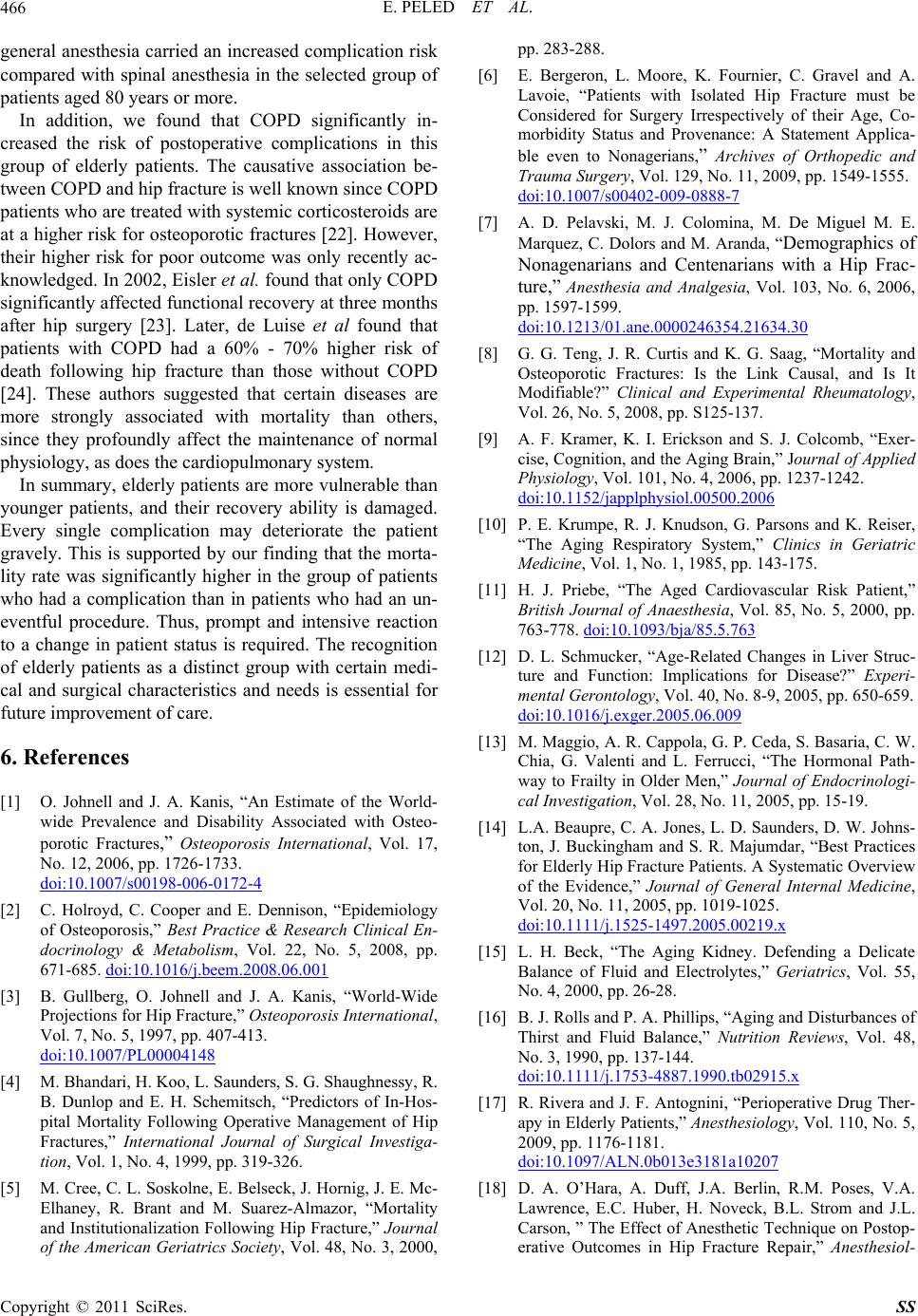
E. PELED ET AL.
466
general anesthesia carried an increased complication risk
compared with spinal anesthesia in the selected group of
patients aged 80 years or more.
In addition, we found that COPD significantly in-
creased the risk of postoperative complications in this
group of elderly patients. The causative association be-
tween COPD and hip fracture is well known since COPD
patients who are treated with systemic corticosteroids are
at a higher risk for osteoporotic fractures [22]. However,
their higher risk for poor outcome was only recently ac-
knowledged. In 2002, Eisler et al. found that only COPD
significantly affected functional recovery at three months
after hip surgery [23]. Later, de Luise et al found that
patients with COPD had a 60% - 70% higher risk of
death following hip fracture than those without COPD
[24]. These authors suggested that certain diseases are
more strongly associated with mortality than others,
since they profoundly affect the maintenance of normal
physiology, as does the cardiopulmonary system.
In summary, elderly patients are more vulnerable than
younger patients, and their recovery ability is damaged.
Every single complication may deteriorate the patient
gravely. This is supported by our finding that the morta-
lity rate was significantly higher in the group of patients
who had a complication than in patients who had an un-
eventful procedure. Thus, prompt and intensive reaction
to a change in patient status is required. The recognition
of elderly patients as a distinct group with certain medi-
cal and surgical characteristics and needs is essential for
future improvement of care.
6. References
[1] O. Johnell and J. A. Kanis, “An Estimate of the World-
wide Prevalence and Disability Associated with Osteo-
porotic Fractures,” Osteoporosis International, Vol. 17,
No. 12, 2006, pp. 1726-1733.
doi:10.1007/s00198-006-0172-4
[2] C. Holroyd, C. Cooper and E. Dennison, “Epidemiology
of Osteoporosis,” Best Practice & Research Clinical En-
docrinology & Metabolism, Vol. 22, No. 5, 2008, pp.
671-685. doi:10.1016/j.beem.2008.06.001
[3] B. Gullberg, O. Johnell and J. A. Kanis, “World-Wide
Projections for Hip Fracture,” Osteoporosis International,
Vol. 7, No. 5, 1997, pp. 407-413.
doi:10.1007/PL00004148
[4] M. Bhandari, H. Koo, L. Saunders, S. G. Shaughnessy, R.
B. Dunlop and E. H. Schemitsch, “Predictors of In-Hos-
pital Mortality Following Operative Management of Hip
Fractures,” International Journal of Surgical Investiga-
tion, Vol. 1, No. 4, 1999, pp. 319-326.
[5] M. Cree, C. L. Soskolne, E. Belseck, J. Hornig, J. E. Mc-
Elhaney, R. Brant and M. Suarez-Almazor, “Mortality
and Institutionalization Following Hip Fracture,” Journal
of the American Geriatrics Society, Vol. 48, No. 3, 2000,
pp. 283-288.
[6] E. Bergeron, L. Moore, K. Fournier, C. Gravel and A.
Lavoie, “Patients with Isolated Hip Fracture must be
Considered for Surgery Irrespectively of their Age, Co-
morbidity Status and Provenance: A Statement Applica-
ble even to Nonagerians,” Archives of Orthopedic and
Trauma Surgery, Vol. 129, No. 11, 2009, pp. 1549-1555.
doi:10.1007/s00402-009-0888-7
[7] A. D. Pelavski, M. J. Colomina, M. De Miguel M. E.
Marquez, C. Dolors and M. Aranda, “Demographics of
Nonagenarians and Centenarians with a Hip Frac-
ture,” Anesthesia and Analgesia, Vol. 103, No. 6, 2006,
pp. 1597-1599.
doi:10.1213/01.ane.0000246354.21634.30
[8] G. G. Teng, J. R. Curtis and K. G. Saag, “Mortality and
Osteoporotic Fractures: Is the Link Causal, and Is It
Modifiable?” Clinical and Experimental Rheumatology,
Vol. 26, No. 5, 2008, pp. S125-137.
[9] A. F. Kramer, K. I. Erickson and S. J. Colcomb, “Exer-
cise, Cognition, and the Aging Brain,” Journal of Applied
Physiology, Vol. 101, No. 4, 2006, pp. 1237-1242.
doi:10.1152/japplphysiol.00500.2006
[10] P. E. Krumpe, R. J. Knudson, G. Parsons and K. Reiser,
“The Aging Respiratory System,” Clinics in Geriatric
Medicine, Vol. 1, No. 1, 1985, pp. 143-175.
[11] H. J. Priebe, “The Aged Cardiovascular Risk Patient,”
British Journal of Anaesthesia, Vol. 85, No. 5, 2000, pp.
763-778. doi:10.1093/bja/85.5.763
[12] D. L. Schmucker, “Age-Related Changes in Liver Struc-
ture and Function: Implications for Disease?” Experi-
mental Gerontology, Vol. 40, No. 8-9, 2005, pp. 650-659.
doi:10.1016/j.exger.2005.06.009
[13] M. Maggio, A. R. Cappola, G. P. Ceda, S. Basaria, C. W.
Chia, G. Valenti and L. Ferrucci, “The Hormonal Path-
way to Frailty in Older Men,” Journal of Endocrinologi-
cal Investigation, Vol. 28, No. 11, 2005, pp. 15-19.
[14] L.A. Beaupre, C. A. Jones, L. D. Saunders, D. W. Johns-
ton, J. Buckingham and S. R. Majumdar, “Best Practices
for Elderly Hip Fracture Patients. A Systematic Overview
of the Evidence,” Journal of General Internal Medicine,
Vol. 20, No. 11, 2005, pp. 1019-1025.
doi:10.1111/j.1525-1497.2005.00219.x
[15] L. H. Beck, “The Aging Kidney. Defending a Delicate
Balance of Fluid and Electrolytes,” Geriatrics, Vol. 55,
No. 4, 2000, pp. 26-28.
[16] B. J. Rolls and P. A. Phillips, “Aging and Disturbances of
Thirst and Fluid Balance,” Nutrition Reviews, Vol. 48,
No. 3, 1990, pp. 137-144.
doi:10.1111/j.1753-4887.1990.tb02915.x
[17] R. Rivera and J. F. Antognini, “Perioperative Drug Ther-
apy in Elderly Patients,” Anesthesiology, Vol. 110, No. 5,
2009, pp. 1176-1181.
doi:10.1097/ALN.0b013e3181a10207
[18] D. A. O’Hara, A. Duff, J.A. Berlin, R.M. Poses, V.A.
Lawrence, E.C. Huber, H. Noveck, B.L. Strom and J.L.
Carson, ” The Effect of Anesthetic Technique on Postop-
erative Outcomes in Hip Fracture Repair,” Anesthesiol-
Copyright © 2011 SciRes. SS